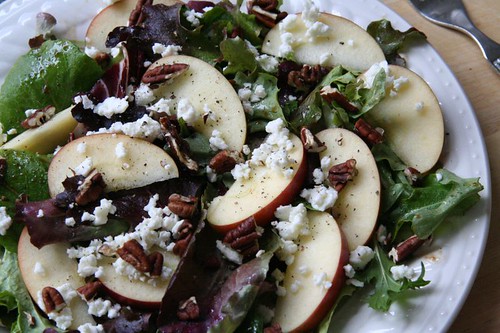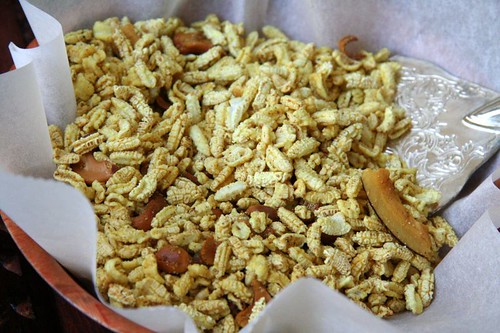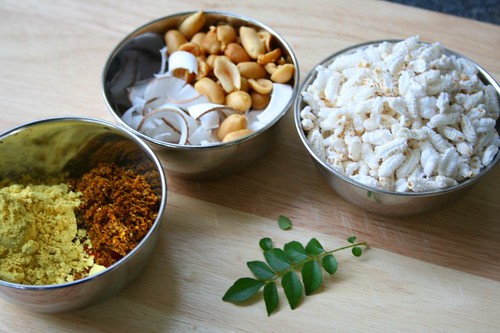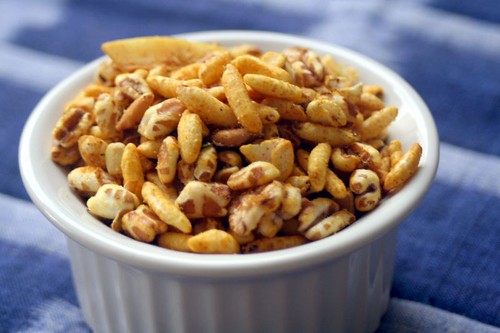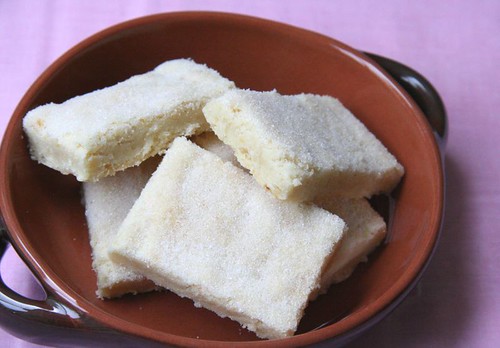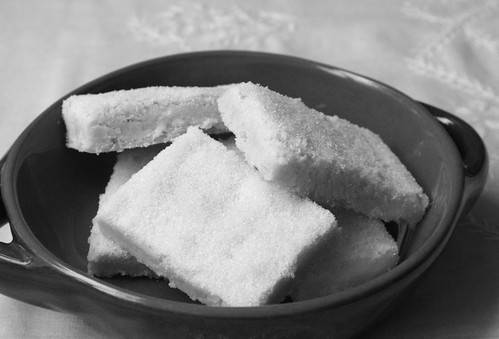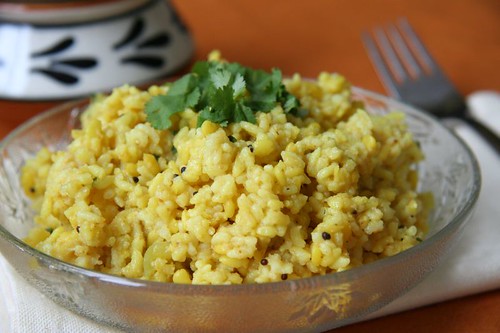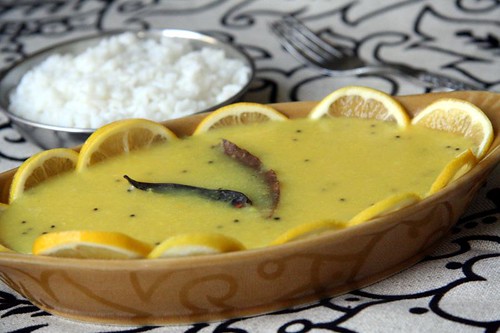Considering that I was fairly familiar with Gujarati food throughout my life, I found out about Dal Dhokli very very late, and when I did, my first reaction was 'whoa, this is like fresh pasta, on steroids!'. As soon as I tasted it, it was such a revelation that something so simple could taste so good, that I had to immediately ask the person who made it, for the recipe, and ever since I have made it several times myself. Dal Dhokli consists of two main parts, the dhoklis which are pieces of thinly rolled out dough, and the thin dal in which they are boiled until cooked. The overall result is thicker than soup, and substantial enough to be eaten as a main dish. This is a very comforting sort of meal, and even good to eat when one is under the weather (like I am right now, unfortunately). A crudites style salad rounds off the meal very nicely. For those not familiar with the dish, I should add that these 'dhoklis' bear no relation to the more popular and accessible 'dhoklas'.
Even though I like my usual recipe a lot, I wanted to try out something different for a change, and I found one that looked good in
'Rotis and Naans of India' by Purobi Babbar which happens to be quite a favorite cookbook of mine. This book is low on contextual information but it is a solid compilation of recipes that always work really well, or at least have worked really well for me so far. Even though the book has recipes for things besides rotis and naans that look very promising, that is the only section I have used.
In this particular case, I don't know why the title in the book says
'Baroda' Dal Dhokli and what it is (if there is anything) that distinguishes it from the Dal Dhokli made in other parts of Gujarat. Perhaps someone like
Priyanka might know. Even though I made several changes to the original, I was rather pleased with the result. Pleased enough to want to use this recipe until I decide to fall back on the old favorite. I did not add any garlic in the tadka as specified, used brown sugar instead of white, and instead of amchoor, the choice of acid was (you guessed it) Meyer lemon juice, squeezed over the dal at the very end. Another thing I did this time (and was left wondering why I didn't think of it before) was to make a double batch of the dhoklis and freeze them, so that next time around I only need to make some dal and pop in the dhoklis.
 Photo taken in a small window of opportunity right before dinner, with the squeezed lemon landing fortuitously in the background.
Photo taken in a small window of opportunity right before dinner, with the squeezed lemon landing fortuitously in the background.Here is my recipe, adapted. The book says it serves 6, but based on experience, I'd say not more than 4.
For the dhoklis1 cup wheat flour (chappati flour, atta)
1/2 teaspoon turmeric
1/2 teaspoon chili powder
1 teaspoon salt
2 teaspoon oil
water for mixing.
Sift the flour and add the spices and salt to it. Rub the oil into the flour, and slowly add water to make a stiff and smooth dough. Divide the dough into 4 or 5 pieces, and roll out each piece into a rectangle about as thick as a chappati. Using a sharp knife or pizza cutter, cut into pieces about 2" X 2" in size.
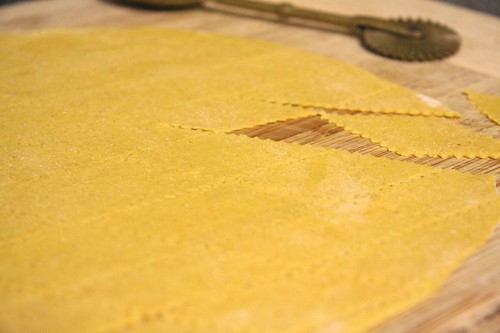 Making the dhoklisFor the dal
Making the dhoklisFor the dal1 cup (or 160 grams) toor dal
1/2 of a medium yellow onion
1 teaspoon turmeric
1-2 teaspoons salt (or to taste)
2 teaspoon brown sugar
1/2 teaspoon garam masala (I used rajwadi)
1 teaspoon amchoor (or lemon juice)
1 Tablespoon oil or ghee
1/2 teaspoon mustard seeds
1/2 teaspoon cumin seeds
5-6 cloves
2-3 dried red chilies (boriya or small round chilies)
10-12 curry leaves
pinch of asafoetida (hing)
2-3 Tablespoons of chopped cilantro
ghee, optional
Chop the onion fine. Cook the dal with turmeric and onion using 5 cups of water, in a pressure cooker or directly on stove top. When it is fully cooked, whisk together until smooth, and add salt and sugar. Bring the dal to a boil, add the rajwadi garam masala. If using amchoor, add it as well. Add the dhokli pieces to the dal, and cook for a few minutes.
In the meanwhile, heat the oil in a small pan for the tempering (vaghaar) to be poured on top. Add the mustard seeds and when they start to pop, add cumin seeds, cloves, chilies, curry leaves and asafoetida, and pour the mixture on the dal. Add the chopped cilantro leaves, and if using lemon juice, squeeze it on top. Add a little ghee, if you like. Tastes best if served immediately.
The old favoriteI am also adding here the usual dal dhokli recipe I have used until now.
For 2-3
For the Dhoklis3/4 cup chappati flour (atta)
1/4 cup besan
1 tsp ajwain
1/2 teaspoon red chili powder (or to taste)
1/2 teaspoon salt (or to taste)
Mix the atta, besan, ajwain, chili powder, and salt, and add enough water to it to make a stiff dough. Roll out the dough, cut it into pieces, separate the individual pieces and leave them on a large tray to dry out for 1-2 hours.
For the dal3/4 cup toor dal
1/2 teaspoon turmeric
2 green chilies
1 inch piece of ginger
about 10 sprigs of cilantro, chopped
1 Tablespoon oil
1/2 teaspoon mustard seeds
1/2 teaspoon cumin seeds
5-10 curry leaves
pinch of fenugreek (methi) seeds
pinch of urad dal
pinch of asafoetida (hing)
1/4 teaspoon cumin powder
1/2 teaspoon coriander powder
salt to taste
Cook dal with turmeric in a pressure cooker. Whisk it to make sure it is smooth. Make a paste of the chilies, ginger, cilantro.
In a large and deep pan, heat the oil, and add the mustard seeds. When they start to pop, add cumin seeds, curry leaves, fenugreek seeds, urad dal, asafoetida, and finally add the cooked dal. Add the ground paste, and plenty of water. Add the cumin and coriander powders and salt. Bring it to a boil. Add the dhokli pieces to the dal and cook it for a few minutes on medium heat until the dal starts to thicken and the dhoklis have softened and cooked.
Freezing Dhoklis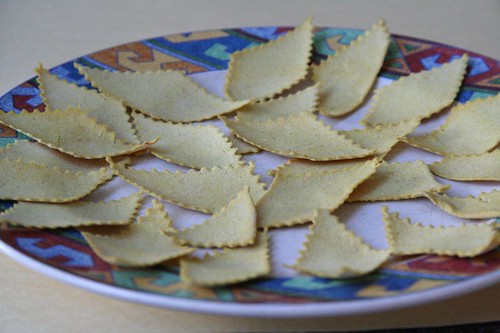
If you wish to freeze dhoklis, lay out the individual dhoklis without crowding on a tray and keep it in the freezer for a few hours, and then transfer to a freezer bag or container and put it back in the freezer. When you are ready to use them, they can be put directly into boiling dal without thawing.
Sending this entry to RCI: Gujarat.

